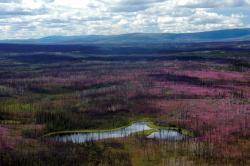Over the past 40 years, fire activity in the boreal forests of North America has increased dramatically, and this increase can be attributed primarily to anthropogenic climatic change; the annual area burned increased from an average of ~12,000 km2 per year in the 1960s to ~30,000 km2 per year in the 1990s. Such short-term historic observations, however, do not capture the full spectrum of boreal fire responses to climate change, and predictive models based on historic observations may be constrained by assumptions derived from climate-fire relationships over the observational record. Holocene paleorecords provide a longer-term perspective on fire-climate relationships, including evidence that changes in the composition of vegetation and abundance of fuels play a key role in shaping fire regimes in Alaska.

Sediment records from lakes like this one, located north of Fairbanks in interior Alaska, reveal the local fire history and vegetation and climate conditions associated with fire. This site burned in 2004, which was a record setting fire season in Alaska—over 2.6 million hectares burned. While any individual year cannot be associated with predicted changes, the activity seen in 2004 is consistent with the trend of increasing fire activity in the boreal forests of North America.
In a project funded by the NSF Arctic Natural Sciences program, Feng Sheng Hu (University of Illinois) and Scott Rupp (University of Alaska) are integrating paleoecological analysis and ecosystem modeling to elucidate the linkages between fire regimes and climate change. They are interested in understanding boreal fire regime dynamics from the past 6,000 years and using this information to simulate possible future trends in the 21st century. Hu and Rupp are working with scientists from the University of Washington and the University of Idaho and graduate students from the University of Illinois.
The research team has conducted field work in the Copper River and Yukon-Old Crow basins, which are located in southcentral and interior Alaska, respectively. These two ecoregions have similar physiography and vegetation but differ in terms of modern fire regime and climate trends.
The researchers extracted sediment cores from more than 30 lakes in the two regions and conducted charcoal analysis of each core to reveal past fire events around each lake. They then statistically interpreted the results to derive the fire history of the two ecoregions during the past 6,000 years. Hu and Rupp also reconstructed climate and vegetation change using paleoecological and isotopic analyses, which allowed examination of fire regime response to a range of temperature and moisture combinations within the context of vegetation change.
The team found that, in certain areas, recent fire regimes are not representative of long-term patterns. For example, over the past 55 years, during which time observations have been collected by the Alaska Fire Service, the boreal forests of the Copper River Basin rarely burned, whereas interior Alaska was characterized by high fire frequency. Over the past 6,000 years, however, the Copper River Basin burned as frequently as interior Alaska. This result implies a dramatic shift in the mechanisms controlling fire occurrence over recent decades, possibly linked to changes in atmospheric circulation patterns affecting storm frequency and/or intensity and duration of summer drought.
The team then used the Alaskan Frame Based Ecosystem Code (ALFRESCO) model to evaluate causal relationships among fire, climate, and vegetation and to simulate regional fires in boreal forests under 21st century climate scenarios. ALFRESCO simulations showed that a change to black spruce dominance around 5,000 years ago led to more frequent fires, despite the development of cooler and wetter conditions.
Preliminary results also suggest that climate warming during the 21st century will initially increase fire frequency and area burned. This increase in fire activity could lead to a shift from conifer-dominated to broadleaf-dominated vegetation. Since deciduous stands have lower flammability than conifers, the increased dominance of broadleaf species would have significant impacts on the structure and function of the boreal forest by the middle of the 21st century. These impacts include changes in vegetation distribution, increases in fire frequency, and changes in the spatial dynamics of vegetation. These changes could shift the boreal forest in interior Alaska into a novel state where smaller, more frequent fires are most common. The simulations suggest that this trend continues until the last several decades of the 21st century, when even deciduous trees burn readily under exceptionally warm and dry climate conditions. This outcome is consistent with the five General Circulation Models that best depict historical climate in Alaska and three emission scenarios from the most recent Intergovernmental Panel on Climate Change report.
The team completed their final field season in summer 2009. Findings are being shared with multiple stakeholders, including the U.S. Fish and Wildlife Service, Bureau of Land Management Alaska Fire Service, National Park Service, Bureau of Indian Affairs, State of Alaska, and private citizens.
For more information, contact Feng Sheng Hu (fshu [at] life.illinois.edu) or Scott Rupp (scott.rupp [at] uaf.edu).
